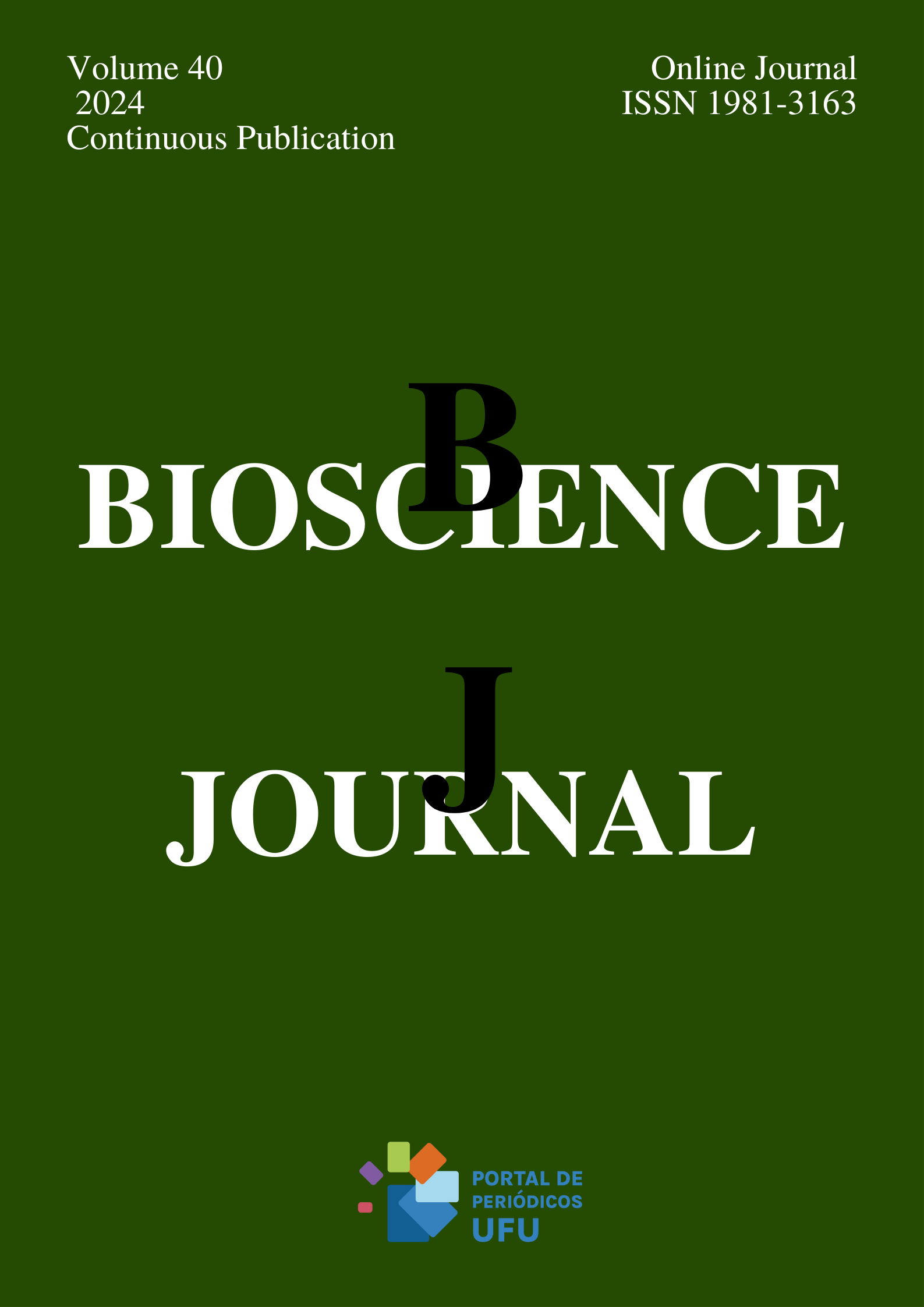Synthesis and evaluation of the antimicrobial activity of purified and unpurified multi-walled carbon nanotubes
DOI:
https://doi.org/10.14393/BJ-v40n0a2024-71916Keywords:
Anti-infective agents, Nanocomposite, Spectrum analysis, Nanotechnology, X-ray diffractionAbstract
Multi-walled carbon nanotubes (MWCNTs) were purified and unpurified in this study to obtain hybrid materials with improved activity. The production stage comprised a chemical purification of the produced sample. Raman spectroscopy analyzed the structural composition of purified and unpurified samples. The disc diffusion assay, minimum inhibitory concentration (MIC), minimum bactericidal concentration (MBC), and time-kill assessment analyzed antimicrobial activity. MWCNT performed well against the tested bacteria (Klebsiella pneumoniae, Pseudomonas aeruginosa, Enterobacter aerogenes, Staphylococcus aureus, and Streptococcus sp. Staphylococcus epidermidis). The disc diffusion assay revealed inhibition zone differences caused by purified and unpurified MWCNTs. MIC and MBC values of purified and unpurified MWCNTs were similar. The purified and unpurified nanotubes of Staphylococcus epidermidis (ATCC 35985) exhibited inhibition zone diameters of approximately 8 mm and 9 mm, respectively. The microdilution method revealed a MIC of 1.23 mg/ml for the purified nanotube and 0.156 mg/ml for the unpurified nanotube against the same microorganism. The killing curve analysis demonstrated that unpurified carbon nanotubes were more effective against all tested microorganisms. MWCNTs represent a promising method for microbiology, but studies on the toxicity of these materials remain scarce.
References
ABO-NEIMA, S.E., MOTAWEH, H.A. and ELSEHLY, E.M. Antimicrobial activity of functionalised carbon nanotubes against pathogenic microorganisms. IET Nanobiotechnology. 2020, 14, 457-464. https://doi.org/10.1049/iet-nbt.2019.0342
AGHAEI, A., et al. Single-walled carbon nanotubes: synthesis and quantitative purification evaluation by acid/base treatment for high carbon impurity elimination. Chemical Papers. 2023, 77, 249–258. https://doi.org/10.1007/s11696-022-02478-5
ALAVI, M., and RAI, M. Recent advances in antibacterial applications of metal nanoparticles (MNPs) and metal nanocomposites (MNCs) against multidrug-resistant (MDR) bacteria. Expert Review of Anti-Infective Therapy. 2019, 17, 419–428. https://doi.org/10.1080/14787210.2019.1614914
ALFEI, S. et al. Reactive Oxygen Species (ROS)-Mediated Antibacterial Oxidative Therapies: Available Methods to Generate ROS and a Novel Option Proposal. International Journal of Molecular Sciences. 2024, 25, 7182. https://doi.org/10.3390/ijms25137182
BALAMURUGAN, S., ASHNA, L. and PARTHIBAN, P. Synthesis of nanocrystalline MgO particles by combustion followed by annealing method using hexamine as a fuel. Journal of Nanotechnology. 2014, 2014, 1-6. https://doi.org/10.1155/2014/841803
CLSI. Methods for determining bactericidal activity of antimicrobial agents; approved guideline M26-A. Clinical and Laboratory Standards Institute. 1999.
CLSI. Methods for dilution antimicrobial susceptibility tests for bacteria that grow aerobically; approved standard M07-A10. Clinical and Laboratory Standards Institute. 2015.
DOVE, A.S. et al. Silver nanoparticles enhance the efficacy of aminoglycosides against antibiotic-resistant bacteria. Frontiers in Microbiology. 2023, 13, 1064095. https://doi.org/10.3389/fmicb.2022.1064095
EL-KADY, M.M., et al. Nanomaterials: A comprehensive review of applications, toxicity, impact, and fate to environment. Journal of Molecular Liquids. 2023, 370, 121046. https://doi.org/10.1016/j.molliq.2022.121046
ELETSKII, A. V. Carbon nanotubes and their possible applications in modern science and technology. Physics-Uspekhi. 1997, 40(9), 899-924. https://doi.org/10.1070/PU1997v040n09ABEH000284
FOO, M.E., et al. Antimicrobial activity of functionalized single-walled carbon nanotube with herbal extract of Hempedu bumi. Surface and Interface Analysi. 2018, 50, 354–361. https://doi.org/10.1002/sia.6375
GRASSI, G., et al. A facile and ecofriendly functionalization of multiwalled carbon nanotubes by an old mesoionic compound. Chemical Communications, 2012, 48, 6836–6838. https://doi.org/10.1039/c2cc31884a
HETTA H.F., et al. Nanotechnology as a Promising Approach to Combat Multidrug Resistant Bacteria: A Comprehensive Review and Future Perspectives. Biomedicines. 2023, 11(2), 413. https://doi.org/10.3390/biomedicines11020413
JUAN, C.A., et al. The Chemistry of Reactive Oxygen Species (ROS) Revisited: Outlining Their Role in Biological Macromolecules (DNA, Lipids and Proteins) and Induced Pathologies. International Journal.
LI, M., et al. Recent advances in nanoantibiotics against multidrug-resistant bacteria, Nanoscale Advances. 2023, 5, 6278-6317. https://doi.org/10.1039/D3NA00530E
LOPES, L. Q. S., et al. Characterisation and anti-biofilm activity of glycerol monolaurate nanocapsules against Pseudomonas aeruginosa. Microbial Pathogenesis. 2019, 130, 178–185. https://doi.org/10.1016/j.micpath.2019.03.007
MACHADO, F. M., SANT'ANNA, M. A., and ALMEIDA, T. Carbon nanotube production and purification: Raman spectroscopy and X-ray diffraction analysis. Journal of Nanoscience and Nanotechnology. 2012, 12(7), 5212-5218. https://doi.org/10.1166/jnn.2012.6143.
MAKSIMOVA, Y.G. Microorganisms and Carbon Nanotubes: Interaction and Applications (Review). Applied Biochemistry and Microbiology. 2019, 55, 1-12. https://doi.org/10.1134/S0003683819010101
MIETHKE, M., et al. Towards the sustainable discovery and development of new antibiotics. Nature Reviews Chemistry. 2021, 5, 726–749. https://doi.org/10.1038/s41570-021-00313-1
NASROLLAHZADEH, M., et al. An Introduction to Nanotechnology. In: Nasrollahzadeh, M., et al. Eds: Interface Science and Technology, Elsevier. 2019, 1-27. https://doi.org/10.1016/B978-0-12-813586-0.00001-8
NEGRI, V., et al. Carbon Nanotubes in Biomedicine. Topics in Current Chemistry, 2020, 378, 1-41. https://doi.org/10.1007/s41061-019-0278-8
PARK, C. et al. Dispersion of single wall carbon nanotubes by in situ polymerization under sonication. Chemical Physics Letters. 2002, 364, 303-308. https://doi.org/10.1016/s0009-2614(02)01326-x
QI, W., et al. The influence of oxygen and oxidative stress on de novo acquisition of antibiotic resistance in E. coli and Lactobacillus lactis. BMC Microbiology. 2023, 23, 279. https://doi.org/10.1186/s12866-023-03031-4
VENTOLA, C. L. The antibiotic resistance crisis: Part 1: Causes and threats. Pharmacy and Therapeutics. 2015, 40(4), 277-283.
WIKLER, M. A., HINDLER, J. F., and TENOVER, F. C. Methods for dilution antimicrobial susceptibility tests for bacteria that grow aerobically: Approved standard M07-A8. Clinical and Laboratory Standards Institute, 2009.
YANG, F., et al. Chirality Pure Carbon Nanotubes: Growth, Sorting, and Characterization. Chemical Reviews. 2020, 120, 2693-2758. https://doi.org/10.1021/acs.chemrev.9b00835
Downloads
Published
Issue
Section
License
Copyright (c) 2024 Leonardo Quintana Soares Lopes, Patrícia Kolling Marquezan, Sergio Roberto Mortari, Fernando Machado Machado, Tiago Moreno Volkmer, Roberto Christ Vianna Santos

This work is licensed under a Creative Commons Attribution 4.0 International License.





